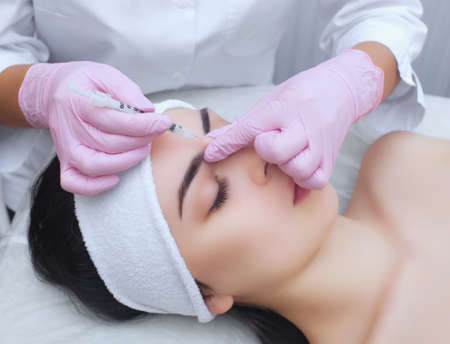1. Understanding Microdermabrasion
Microdermabrasion is a non-invasive skincare treatment designed to gently exfoliate the outermost layer of your skin. This procedure uses a specialized device with fine crystals or a diamond-tipped wand to remove dead skin cells, revealing a smoother and more radiant complexion underneath.
How Microdermabrasion Works
The process involves using a handheld device that sprays tiny crystals onto the skin or employs a diamond tip to buff away dead cells. Simultaneously, a vacuum suction system removes the exfoliated skin particles, promoting better circulation and stimulating collagen production.
Benefits of Microdermabrasion
Microdermabrasion offers several benefits for those looking to improve their skin’s texture and tone. Here are some key advantages:
| Benefit | Description |
|---|---|
| Smoother Skin Texture | Removes rough, uneven skin for a softer feel. |
| Brighter Complexion | Eliminates dullness by sloughing off dead skin cells. |
| Minimized Pores | Cleans out pores, reducing their appearance over time. |
| Reduced Fine Lines | Mild resurfacing helps soften early signs of aging. |
| Better Product Absorption | Your skincare products penetrate deeper for improved effectiveness. |
What Skin Concerns Does Microdermabrasion Address?
This treatment is ideal for addressing mild to moderate skin concerns. It works well for individuals dealing with:
- Dull or uneven skin tone
- Mild acne scars or hyperpigmentation
- Slight fine lines and wrinkles
- Sensitive skin that may not tolerate harsher treatments like chemical peels
Who Should Consider Microdermabrasion?
If youre looking for a gentle yet effective way to refresh your skin without downtime, microdermabrasion might be the right option for you. However, those with active acne, deep scars, or severe pigmentation issues may need stronger treatments like chemical peels.
2. Exploring Chemical Peels
Chemical peels are a popular skincare treatment that uses chemical solutions to exfoliate the skin, removing dead cells and promoting new cell growth. They help improve skin texture, tone, and overall appearance by addressing concerns like fine lines, acne scars, hyperpigmentation, and uneven skin tone.
Types of Chemical Peels
There are three main types of chemical peels, each offering different levels of exfoliation and benefits:
| Type | Strength | Benefits | Recovery Time |
|---|---|---|---|
| Superficial Peel | Mild | Improves skin texture, brightens complexion, and helps with mild acne | Minimal (a few hours to a day) |
| Medium Peel | Moderate | Reduces fine lines, evens out skin tone, and treats acne scars | A few days to a week |
| Deep Peel | Strong | Dramatically improves wrinkles, sun damage, and severe pigmentation issues | A few weeks |
How Chemical Peels Improve Skin Texture and Tone
Chemical peels work by accelerating the natural shedding process of the skin. As the old layers peel away, fresher and healthier skin emerges. The depth of peeling depends on the type used:
- Mild peels: Provide a gentle refresh by removing surface-level dead skin cells.
- Medium peels: Penetrate deeper to reduce discoloration and stimulate collagen production.
- Deep peels: Reach the lower layers of the skin to address deep wrinkles and significant imperfections.
Is a Chemical Peel Right for You?
If you’re looking for noticeable improvements in your skins texture and tone with varying levels of intensity, chemical peels might be a great option. However, deeper peels require more recovery time and may not be suitable for all skin types. Consulting with a skincare professional will help determine which type is best for your specific concerns.

3. Key Differences Between Microdermabrasion and Chemical Peels
When deciding between microdermabrasion and chemical peels, understanding their key differences can help you choose the best option for your skin type and concerns. Let’s break down how these treatments compare in terms of procedure, recovery time, effectiveness, and ideal candidates.
Procedure
Microdermabrasion
Microdermabrasion is a non-invasive procedure that uses a handheld device to exfoliate the outermost layer of dead skin cells. This is done using fine crystals or a diamond-tipped wand that gently buffs the skin, promoting cell turnover and improving texture.
Chemical Peels
Chemical peels involve applying a chemical solution to the skin, which causes controlled exfoliation and peeling over several days. The depth of the peel varies—light, medium, or deep—depending on the strength of the acids used.
Recovery Time
| Treatment | Recovery Time |
|---|---|
| Microdermabrasion | No downtime; mild redness for a few hours |
| Chemical Peels (Light) | Minimal downtime; slight redness or flaking for a few days |
| Chemical Peels (Medium) | Peeling lasts about a week; some redness may persist |
| Chemical Peels (Deep) | Several weeks of recovery; significant peeling and redness |
Effectiveness
Microdermabrasion
This treatment is effective for mild skin concerns such as dullness, uneven texture, and minor blemishes. It provides an instant glow but requires multiple sessions for lasting results.
Chemical Peels
Chemical peels are more effective for deeper skin concerns like hyperpigmentation, acne scars, fine lines, and wrinkles. Stronger peels yield more dramatic results but require longer recovery times.
Ideal Candidates
| Treatment | Best For |
|---|---|
| Microdermabrasion | Those with sensitive skin, minor texture issues, or looking for a quick refresh with no downtime. |
| Chemical Peels (Light) | Individuals with mild discoloration, fine lines, or acne-prone skin. |
| Chemical Peels (Medium to Deep) | People with deeper wrinkles, sun damage, or stubborn pigmentation willing to undergo a longer healing process. |
The choice between microdermabrasion and chemical peels depends on your specific skin goals, tolerance for downtime, and desired level of exfoliation. If youre unsure which treatment is right for you, consulting with a skincare professional can help guide your decision.
4. Which Treatment Is Best for Your Skin Type?
Choosing between microdermabrasion and chemical peels depends on your skin type and specific concerns. Both treatments offer unique benefits, so lets break down which option is best for different skin issues.
Microdermabrasion vs. Chemical Peels: Skin Concerns
If youre dealing with acne scars, fine lines, hyperpigmentation, or dull skin, heres how each treatment compares:
| Skin Concern | Microdermabrasion | Chemical Peel |
|---|---|---|
| Acne Scars | Mild improvement for shallow scars | More effective for deeper scars |
| Fine Lines & Wrinkles | Smooths surface-level lines | Better for deeper wrinkles |
| Hyperpigmentation | Mild brightening effect | Treats stubborn dark spots more effectively |
| Dull Skin | Instant glow with no downtime | Brighter results but may require downtime |
Your Skin Type Matters
The effectiveness of microdermabrasion and chemical peels also depends on your skin type:
- Sensitive Skin: Microdermabrasion is gentler and less likely to cause irritation.
- Oily & Acne-Prone Skin: Chemical peels can help control oil production and unclog pores.
- Mature Skin: Chemical peels are often better for addressing deeper wrinkles and age spots.
- Darker Skin Tones: Microdermabrasion is generally safer, while certain chemical peels require caution to avoid hyperpigmentation.
A Customized Approach
If youre unsure which treatment is best for you, consult a skincare professional. They can assess your skin type and recommend the most suitable option based on your goals and sensitivity levels.
5. What to Expect During and After the Procedure
Understanding what happens during and after microdermabrasion and chemical peels can help you prepare for the treatment and achieve the best results. Here’s a breakdown of what to expect from each procedure, including potential side effects and post-care tips.
What Happens During the Treatment?
Microdermabrasion
Microdermabrasion is a quick, non-invasive procedure that typically takes 30 to 60 minutes. A skincare professional uses a special device to exfoliate the outer layer of dead skin cells using fine crystals or a diamond-tipped wand. The process is painless, with most people describing it as a mild scratching sensation.
Chemical Peels
Chemical peels involve applying a solution containing acids like glycolic, salicylic, or lactic acid to remove damaged layers of skin. The strength of the peel determines how deep it penetrates. Light peels may cause a slight tingling sensation, while medium and deep peels can cause more intense stinging or burning for a few minutes.
Potential Side Effects
Both treatments come with minimal downtime, but side effects vary depending on the type and depth of the procedure.
| Treatment | Common Side Effects | Downtime |
|---|---|---|
| Microdermabrasion | Mild redness, slight sensitivity, temporary dryness | No downtime; normal activities can be resumed immediately |
| Chemical Peels | Redness, peeling, flaking, sensitivity (depends on peel strength) | A few hours to several days; deeper peels require longer recovery |
Post-Care Tips for Best Results
After Microdermabrasion:
- Avoid direct sun exposure for at least 24 hours.
- Use a gentle moisturizer to keep skin hydrated.
- Avoid harsh skincare products like retinoids for a few days.
- Stay hydrated to promote skin healing.
After Chemical Peels:
- Avoid picking or peeling flaking skin to prevent irritation.
- Diligently apply sunscreen to protect fresh skin from sun damage.
- Mild cleansers and fragrance-free moisturizers help soothe irritation.
- Avoid makeup for at least 24 hours (longer for deeper peels).
The right post-care routine will maximize your results and ensure your skin heals properly. Always follow your skincare professional’s recommendations for the best outcome.


